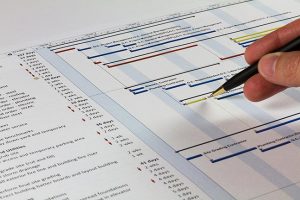
Due to expertise or resource constraints, many projects require external resources to complete their work. These resources can come from either the project’s parent organization or from external sources. But regardless of how they are obtained, project procurement is one of the most exciting areas of project management but also results in the biggest headeaches for the project management team.
The project procurement management process falls neatly within the four standard project management phases:
- Planning
- Execution
- Control
- Closure
The Project Management Body of Knowledge (PMBOK Guide) adds one more at the beginning – Initiating. However, it is small and there are no items from the procurement knowledge area within it.
Planning
 The initial, planning phase represents the part when the procurements are identified and defined:
The initial, planning phase represents the part when the procurements are identified and defined:
- What needs to be procured?
- How will it be procured?
- Who is responsible for procuring it?
- Who will write the procurement documents?
- When will it be procured?
- When will the contract completion dates be?
During the planning phase, there are two documents that the project manager has in their toolkit:
- The procurement management plan is a document that is specified in the project management body of knowledge (PMBOK) and defines the policies and procedures to be used in the procurement activities. Contract types and selection methods are defined and provide strategy and direction to the procurement activities of the project management team.
- The statement of work (also known as terms of reference) is the technical statement of the work that is required of a contractor. It often becomes part of the contract.
The project manager also utilizes capital budgeting methods like the net present value, payback period, and internal rate of return, to compare various project options.
The procurement management plan contains the strategy, processes, and any other information required to guide the project manager throughout the procurement activities. It specifies the types of contracts that the project will employ.
- Fixed fee contracts, also called lump sum, require the contractor to specify one single price for one item of work. The contractor assumes all risk of project changes and prices the possibility and severity of those changes into their price.
- Cost Plus contracts have a variable component (cost) and a fixed component (plus). The variable component reimburses the contractor for costs, and the fixed component represents profit. The contractor invoices the actual, rather than bid, costs for the variable portion and receives the fixed portion regardless. Hence, the variable portion is usually paid based on time and materials, submitted with invoices, while the fixed portion is paid based on percent complete. There are several variations to the cost plus model, particularly using the fixed fee as an incentive bonus/penalty to motivate the contractor to reduce the variable portion.
- Time and Materials contracts are similar to Cost Plus but do not contain a fixed portion (profit). That’s not to say there is no profit expected for the contractor, rather the contractor embeds the profit into the unit rates of the people and equipment in the project. Hence, the entire fee is variable and billed by time and materials expended. To prevent a runaway project budget, there is usually some sort of “upset limit” which cannot be exceeded without authorization.
Execution
 During the project execution phase, the procurements identified in the procurement management plan are put into practice. This can vary from project to project and contract to contract, but generally contain the following four steps:
During the project execution phase, the procurements identified in the procurement management plan are put into practice. This can vary from project to project and contract to contract, but generally contain the following four steps:
- Preparation of the statement of work / terms of reference
The list of tasks and deliverables, as well as project descriptions are developed to ensure that the contractor is familiar with the work that needs to be done. This document needs to be comprehensive. If even one thing is missing, the contractor has grounds to ask for more money because there is work that must be performed that is not part of the contract. There are often many grey areas. Reputable contractors will require clarification during the bidding process because they will not want to be outbid by shady contractors who see the hole and submit a lower bid hoping to receive a future increase to the project budget. - Development of estimate
In most procurement situations you need to have an estimate prior to tendering, to ensure the money is there when the tenders are received. - Preparation of bid documents
Further to the statement of work / terms of reference which state the technical work requirements, the bid documents itemize the logistical information, such as how/where to submit the bid, insurance and bonding requirements, and general specifications. These are often called Invitation to Tender, Request for Proposal (RFP), or Request for Quotation (RFQ). - Advertising of contract
The tender (contract prior to being awarded) is advertised in a location where contractors are likely to view it. A contractor is selected based on the selection criteria identified. - Performance of work
Once the contract is in place, the work is performed. The quality and timing are usually inspected regularly via project updates or site inspections. Often major items that have a large impact on the contractor are inspected in fabrication, or at an early milestone where they can be rejected with the least impact. Any work that is outside of the contract must be reported immediately and should not be performed until approval is granted, although this is sometimes easier said than done. The work in question can be small but hold up larger parts of the project, creating large cost implications.
Control
 Project control in the area of procurement involves quality control inspections on the contractor’s work. The contractor has specifications that they must follow, which include technical specifications and milestone dates (among other items). But many things can be exaggerated, stretched, or outright fudged without the owner finding out. So how do you know the contractor is producing the work to the standards identified?
Project control in the area of procurement involves quality control inspections on the contractor’s work. The contractor has specifications that they must follow, which include technical specifications and milestone dates (among other items). But many things can be exaggerated, stretched, or outright fudged without the owner finding out. So how do you know the contractor is producing the work to the standards identified?
In the construction industry, project control is a critical undertaking involving full time inspectors at the job site. The inspectors ensure that the project is built according to the plans, and that any parts that are covered up (cast-in-place concrete, interior walls, etc.) are satisfactory.
In professional project management, project control activities occur on a regular cycle, for example weekly or monthly. Each task of the project is assessed using earned value management to determine if the task (and greater project) is on time and budget. But the external contractor’s work is usually ascribed one single task and the owner gives up day to day control of that task to the contractor. For that reason, the project manager should request progress updates from the contractor on the same schedule as their own project progress reporting.
Closure
 Most contracts require closure in the form of an acceptance certificate which communicates that the contractor’s work is under the contract is legally complete.
Most contracts require closure in the form of an acceptance certificate which communicates that the contractor’s work is under the contract is legally complete.
Also, most organizations tend to look back at past projects to plan and estimate future projects, and external contracts should compile and document their important information for future reference, particularly the cost of the work vs. what work was performed for that price. Finally, as-built information needs to be generated.
The closure activities include:
- Completion certificates
- As built plans
- Final contract costs
- Final reports which detail the project issues encountered and remedies (lessons learned report)
Project procurement management can be exciting and rewarding, but it will put your management skills to the test. Good luck with your procurements and let us know what your experience is in the comments.






